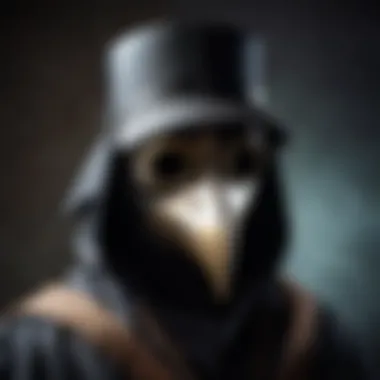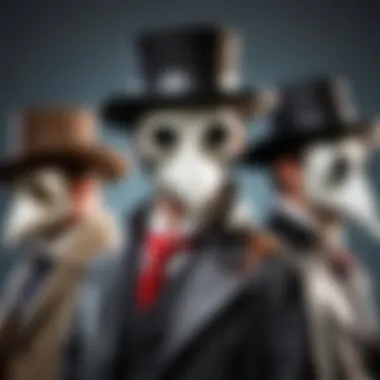Exploring Major Grom and the Plague Doctor's Themes


Intro
The world of literature often serves as a mirror to society, reflecting its intricacies and dilemmas. Within this realm, Major Grom: Plague Doctor emerges not only as a narrative but as a commentary on contemporary socio-political dynamics. This article aims to lay out the pivotal themes and character nuances found in this work, providing a detailed analysis that resonates with readers ranging from bibliophiles to students.
Основные жанры литературы
Understanding the fundamental genres of literature enhances our grasp of texts like Major Grom. Literature can be classified into several categories. Each genre presents unique characteristics that shape storytelling.
Классификация по жанрам
- Fiction: This genre encompasses imaginative narration, giving life to characters and scenarios that may or may not exist in reality.
- Non-fiction: Rooted in facts, this genre aims to inform or educate the reader, frequently found in biographies or essays.
- Poetry: Often more abstract, poetry conveys feelings and images through rhythmic and compact language.
- Drama: Scripts and plays belong here, where action unfolds primarily through dialogue and performance.
Особенности каждого жанра
Each genre allows for distinct methods of expression:
- Fiction often employs character development and plot twists.
- Non-fiction focuses on clarity and factual accuracy.
- Poetry utilizes metaphor and symbolism to evoke emotion.
- Drama concentrates on the immediacy of performance, where dialogue drives the story.
These distinctions lay the foundation for understanding narrative structures and thematic depths in Major Grom: Plague Doctor.
Рецензии на книги
Reviews of literary works, especially those gaining significant popularity, offer insight into their reception and influence.
Обзор популярных книг
Major Grom: Plague Doctor is a notable work that has captured attention due to its blend of action, drama, and social commentary. Observing its reviews reveals how it resonates with readers and critics alike.
Анализ литературных произведений
Analyzing this text requires attention to its main character, Igor Grom, whose moral conflicts exemplify larger societal questions. The narrative serves as a lens through which the reader can explore issues such as justice and authority.
Prelims to Major Grom
The topic of Major Grom holds a prominent place in contemporary discussions of Russian literature and culture. This introduction sets the stage for a deeper understanding of the narrative's nuances, characters, and its relationship to societal issues. It serves as a gateway to the broader themes explored in the series, illustrating how Major Grom's story resonates with its audience, both in Russia and beyond.
Overview of the Narrative
Major Grom, a pivotal figure in the graphic novel and film adaptations, portrays the journey of a policeman who confronts moral dilemmas and societal decay. The narrative weaves together action and drama while reflecting current issues prevalent within Russian society. Readers find themselves immersed in a world where justice is often obscured by corruption and cruelty. This duality in storytelling forms a compelling backdrop that captivates the audience.
The progression follows Major Grom as he confronts a mask-wearing antagonist known as the Plague Doctor. The conflict is not just personal; it embodies a larger struggle against systemic injustice and a question of whether the ends justify the means. This dynamic offers a thrilling narrative that prompts critical reflection on the nature of law and order.


Major Grom’s character development is central to the narrative’s impact. His evolution from a by-the-book policeman to a figure navigating the gray areas of morality provides depth and relatability. Readers witness his trials and tribulations, which echo broader themes of sacrifice, duty, and the complexities of human nature.
Historical Context
To fully grasp the depth of Major Grom’s story, one must consider its historical context. Set against a backdrop of contemporary Russia, the narrative reflects an era marked by political turbulence and social strife. The rise of modernity, alongside its discontents, is a recurring motif that shapes the landscape within which the characters operate.
Major Grom emerges from a Russian cultural milieu that often grapples with its past and seeks to define its identity in a changing world. The historical undertones enhance the relevance of the storyline, making it not merely a work of fiction but a commentary on the collective consciousness of a society striving for justice and order.
Character Analysis
Character analysis plays a significant role in understanding the intricate dynamics within 'Major Grom: Plague Doctor'. It provides depth to the narrative and illuminates the motivations and conflicts of the individuals that drive the story forward. Characters are not mere vehicles for the plot; they embody the thematic elements present, enabling a broader reflection on society and morality. The analysis allows readers to grasp the complexities of each character, enhancing comprehension of the narrative's socio-political commentary, thus building an enriching backdrop for the unfolding events.
Major Grom: The Protagonist
Major Grom serves as the central figure around whom the entire narrative revolves. He is a complex character shaped by his past and deeply ingrained beliefs about justice and lawfulness. As a police officer, he embodies the struggle against systemic corruption that permeates society. Grom's dedication to uncovering the truth is commendable, but his methods often lead him onto morally ambiguous paths. This duality provides an engaging exploration of duty versus personal ethics.
His character development is pivotal as it mirrors the tensions present in the narrative. Grom's journey, influenced by personal loss and betrayal, raises questions about the lengths one will go to for justice. The evolution of his character is not merely a personal arc; it reflects broader themes regarding societal trust in institutions and the ethical dilemmas individuals face in moments of crisis.
The Plague Doctor: Symbolism and Role
The Plague Doctor emerges as a key figure, representing not only a formidable antagonist but also a complex symbol of fear and social critique. His enigmatic persona is closely tied to the thematic exploration of fear as a tool of manipulation. By orchestrating chaos through masked intentions, he reflects how fear can be cultivated and wielded by those in power.
Moreover, the character's mask, an iconic element, serves multiple purposes. It signifies anonymity and the disconnection of the individual from their actions. It challenges Grom and those around him, forcing them to confront uncomfortable truths about their society and themselves. The Plague Doctor can also be seen as a representation of a societal illness, where corruption and moral decay are pervasive, much like a plague.
Supporting Characters And Their Impact
The supporting characters in 'Major Grom: Plague Doctor' play crucial roles in shaping the protagonist’s experience and, by extension, the narrative's direction. Each character embodies different facets of society, offering counterpoints to Grom's worldview.
- Anna: A fellow police officer, symbolizes loyalty and friendship but also presents a more grounded perspective on law enforcement. Her role provides insight into the institutional challenges and the psychological toll on those within the system.
- The Politician: This character illustrates the dark interplay of power and corruption. His actions highlight the complicity of those in authority, making the stakes for Grom's fight against the Plague Doctor even more significant.
- The Journalist: As a voice of the public, this character represents the quest for truth. It is through their inquiries that Grom's struggles are amplified, showcasing the importance of media in exposing societal issues.
Supporting characters inject life into the narrative, making the themes of justice, corruption, and morality resonate more intensely. Their various perspectives and interactions with Grom enrich the storyline and enhance the exploration of underlying societal issues.
Thematic Exploration
The thematic exploration within Major Grom: Plague Doctor is critical. It sheds light on various social, moral, and psychological elements that resonate with contemporary issues. Each theme weaves a complex narrative, allowing the audience to reflect on their values and beliefs. Analyzing these themes provides insights into how the story reflects broader societal challenges and human complexities.
Justice and Morality
The theme of justice and morality plays a pivotal role in the narrative. Major Grom embodies the struggle between personal moral codes and societal expectations. He faces dilemmas that challenge his sense of right and wrong. The narrative prompts readers to question the balance between justice and vengeance. Moreover, it presents the idea that absolute justice is often unattainable in a corrupt society.
- Readers witness Grom's internal conflicts as he navigates his role as an enforcer of the law.
- The duality of justice is illustrated through interactions with other characters, who represent various moral viewpoints.
This duality forces the audience to reflect on what true justice means in their own lives. It invites discussions about ethical frameworks and the consequences of moral decisions.


Corruption and Power Dynamics
In the narrative, corruption and power dynamics significantly influence character relationships and plots. The story unfolds against a backdrop of systemic corruption where authority figures often exploit their power.
- The Plague Doctor symbolizes the dark implications of power. His character challenges the status quo, representing a force against the corruption.
- The interaction between Grom and corrupt officials highlights the struggle for accountability in governance.
This theme resonates strongly with current global events, where similar issues appear in many societies. Analyzing this aspect unveils how power can corrupt and how individuals respond to such environments.
The Nature of Fear
Fear is another essential theme woven throughout the story. It manifests in various forms, including fear of the unknown and fear imposed by authority.
- Major Grom's journey reflects personal fears, confronting not only external threats but also internal insecurities.
- The Plague Doctor uses fear as a tool, instilling dread in those he targets, which raises questions about the morality of using fear for control.
This theme encourages readers to consider the role of fear in their lives and societies. It examines how fear can manipulate actions and choices, ultimately shaping human behavior.
Cultural Significance
The cultural significance of Major Grom: Plague Doctor cannot be overstated. This narrative extends beyond mere entertainment to serve as a lens through which to examine contemporary Russian society. Through a meticulous exploration of themes and characters, it prompts discourse on moral dilemmas, political structures, and societal constructs. The series reflects the anxieties and aspirations prevalent in modern Russia while offering insights into the collective consciousness of its people.
Representation of Russian Society
The way Major Grom portrays Russian society is particularly compelling. It does not shy away from representing the complexities and contradictions inherent in the community. The protagonist, Major Grom, embodies a figure of justice but exists within a system fraught with corruption. This duality serves as a commentary on the moral conflicts faced by individuals in authority.
Moreover, the societal backdrop is rich with cultural references that resonate with the Russian public. The portrayal of familiar settings juxtaposes everyday life with extraordinary circumstances. The thematic emphasis on justice not only resonates on an individual level but also speaks to a broader societal yearning for accountability and reform.
The series invites viewers to critically assess their environment, pushing the audience to reflect on their own values and beliefs.
Comparative Analysis with Global Works
When comparing Major Grom: Plague Doctor with global works, it becomes clear that its narrative tackles universal themes, albeit through a distinctly Russian lens. The exploration of power dynamics, morality, and fear is not unique to Russia. For instance, comparisons can be drawn with works like Watchmen by Alan Moore and V for Vendetta. Both narratives explore similar themes, yet Major Grom adds its own cultural texture.
The linguistic style and narrative choices used in Major Grom may differ from those in Western literature, which can influence how these themes are perceived. For example, the directness of dialogue and stark character contrasts emphasize urgency and conflict unique to the Russian experience.
Furthermore, the representation of authority figures in Major Grom mirrors global concerns about trust in leadership and societal behavior, making it relevant to a broader audience that extends past Russian borders.
Overall, the cultural significance of Major Grom: Plague Doctor lies in its ability to bridge local representations with universal themes, offering rich material for analysis and discussion.
Artistic Elements
The exploration of artistic elements is vital for understanding the depth and breadth of Major Grom: Plague Doctor. Artistic choices affect how narratives resonate and how thematic layers unfold. This section addresses the stylistic components of the narrative and the accompanying visual representation, which critically shape the viewer's experience.


Stylistic Choices in Narrative
The narrative style of Major Grom: Plague Doctor combines straightforward storytelling with intricate character development. The pacing is deliberate, allowing the audience to absorb the contextual layers in each scene. Dialogue is crafted to reflect authentic emotions while driving the plot forward.
Key stylistic choices include:
- Dialogue Usage: The characters engage in conversations that reveal their fears, motivations, and conflicts. This approach helps in developing empathy toward the protagonist and understanding opposing viewpoints.
- Narrative Perspective: The use of third-person limited perspective lets readers gain insights into Major Grom's internal struggles while simultaneously witnessing the world around him. This duality creates tension and engagement, offering a deeper layer to the protagonist's journey.
The selection of language is straightforward yet impactful. This accessibility serves to draw in a wider audience, making complex themes more approachable.
Visual Representation and Graphics
Visual elements significantly enhance the narrative in Major Grom: Plague Doctor. The graphics and animation work towards creating an immersive world that reflects the often grim tone of the story. Character designs emphasize their traits, allowing viewers to quickly grasp their roles and emotional states.
Several aspects contribute to the visual narrative:
- Color Palette: The use of a muted color scheme mirrors the thematic elements of despair and conflict, grounding the audience in the grim reality of the world Major Grom inhabits.
- Art Styles: The incorporation of comic book aesthetics adds depth. It engages viewers who appreciate the graphic novels while providing a fresh perspective on the story.
Illustrative choices here are not merely decorative; they serve to heighten meaning and encourage the audience to contemplate the underlying questions posed by the narrative.
Reception and Critique
The topic of reception and critique is essential in the analysis of any narrative, particularly for a series like Major Grom: Plague Doctor. Understanding how critics and audiences respond to narratives provides insight into both the content and the broader cultural context. Reception indicates how well the material is perceived, while critique offers a deeper evaluation of its artistic and thematic choices. Thus, analyzing these aspects can reveal much about the societal values and expectations of the audience.
Critical Response to the Series
The critical response to Major Grom: Plague Doctor has varied. Critics have often commended the series for its compelling storytelling, which cleverly intertwines elements of action, horror, and socio-political commentary. The character of Major Grom, depicted as a dedicated investigator, captures the struggle between personal convictions and systemic corruption. Many theorists have argued that this tension mirrors contemporary societal issues in Russia.
Landmarks of criticism typically highlight the intricate layering of themes such as morality, justice, and fear. Critics also note the series' unique presentation of graphic violence stemming from the Plague Doctor's actions. Furthermore, the series' aesthetic choices in animation and narrative pacing have received both praise and critique, leading to diverse opinions on its effectiveness in conveying deeper messages. Critics appreciate the ambition behind the project but sometimes remark on pacing issues that can detract from character development.
Audience Reception and Popularity
Audience reception is as significant as critical analysis. Fans of the Major Grom series have embraced the storyline enthusiastically. The engagement of the audience can be attributed to how the narrative resonates on a personal level. Many viewers find the exploration of fear and hopelessness relatable in the context of current global challenges. Social media platforms, such as Reddit and Facebook, reveal lively discussions on character arcs and thematic implications, demonstrating a vibrant fan community.
Ratings from platforms such as MyAnimeList indicate a favorable reception, with many users applauding the plot's unexpected turns and the moral dilemmas faced by Major Grom. The character of the Plague Doctor has sparked particular intrigue, symbolizing both fear and the struggle against a societal malaise. The popularity extends beyond Russia as international viewers find parallels in their own societal contexts, contributing to an expanding fanbase.
Overall, examining the reception and critique of Major Grom: Plague Doctor sheds light on its relevance in contemporary discussions around morality, justice, and the complexities of societal dynamics. The interplay between audience reception and critical response underscores the work’s significance in both local and global literary landscapes.
The End
The conclusion serves as the final juncture in the exploration of the intricate world of Major Grom and the Plague Doctor. It encapsulates the essence of the preceding discussions, emphasizing the critical aspects discussed throughout the article. By synthesizing the key themes, character arcs, and socio-political contexts, the conclusion reinforces the central arguments articulated.
Final Thoughts on Major Grom
Major Grom as a protagonist represents a larger narrative within Russian culture, embodying both the struggles and aspirations of contemporary society. The character's journey throughout the series not only provides entertainment but also prompts a reflection on morality, justice, and the various shades of human nature. Grom's experiences resonate with readers seeking meaning in complex moral landscapes, making him a compelling figure in modern literature. His character is a lens through which complex dilemmas can be examined, encouraging an introspective approach to the themes presented in the narrative.
The Lasting Legacy of the Plague Doctor
The Plague Doctor has a significant and multifaceted role in the series, encapsulating not just an antagonist but also a symbol of fear and societal turmoil. This character effectively highlights the inherent anxieties present in both historical and contemporary contexts. The legacy of the Plague Doctor extends beyond fiction; it provokes thoughtful discourse on the nature of power, fear, and the societal impacts of corruption. Analyzing this character encourages a deeper understanding of how external forces can shape individual actions and societal responses. As readers engage with this complex narrative, the Plague Doctor's legacy transcends the pages, leaving a lasting impression that inspires ongoing conversation and reflection.



